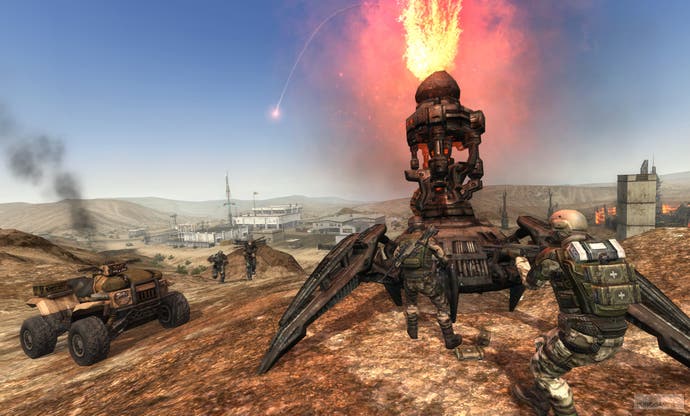Enemy Territory: Quake Wars
These are hostile waters.
Indeed, vehicular fun is such a large part of the game that the more basic combat plays second fiddle, to some degree. There are five classes in the game - soldier, medic, engineer, covert ops and field ops. Several objectives require one specific class to complete them; the soldier, for example, is needed to take on "Destroy" objectives, while the covert ops class is the only one which can hack computer systems.
Each of the classes, of course, can fight; the specialised combat roles here being the soldier, which has the widest range of available weaponry, and the covert ops guy, who is the only class which can carry a sniper rifle. The medic can, of course, heal, and can also raise dead comrades; the engineer and field ops classes, meanwhile, build defensive and offensive turrets respectively, with the engineer repairing machinery while the field ops class goes out to "paint" targets for his artillery pieces.
The actual process of fighting, however, feels a little weak at times - perhaps because of unrealistic expectations on our part. We were anticipating a more Quake-like experience, but Enemy Territory instead delivers an attempt at a realistic battlefield. Weapons are wildly inaccurate when you're moving around, and players are remarkably squishy - none of the long, drawn-out rocket duels of Quake here, instead a rattle of machine gun fire is enough to see off any foe, assuming you can hit them.
This isn't a bad system by any means, and if anything it emphasises the focus on tactics and strategy rather than individual skill. However, it's not really Quake, which rankled with us in the first few hours of play - although we confess that we rapidly came around to the idea that Quake Wars was offering more than enough shiny new toys to justify the loss of rocket jumping.
Send Reinforcements
Indeed, shiny is a word which we'd happily use for Quake Wars - because aside from our lingering concern over the game's general unfriendliness for new players, we are very impressed by the sheer amount of polish Splash Damage have lavished on the title. Evidence of serious thought abounds in the game mechanics; the drops of reinforcements every 25 seconds, for example, give combat a "wave" nature, allowing defenders to catch their breath momentarily before the next batch of attackers arrives, which is a lovely system.

A similarly fantastic piece of design is the placement system for turrets and other deployables, which puts you into a zoomed-out third-person mode and allows you to place and rotate the item using controls that will be familiar to anyone who has played Command and Conquer. It's a textbook example of a good design idea from one genre crossing over into another, and is probably a large part of the reason why we like playing the engineer so much.
Despite the obvious thought and loving care which has gone into certain parts of the game, there are other aspects which raise question marks in our minds. The balance between the Strogg and human forces, for one thing, seems to be just about perfect technically - but perhaps not in terms of enjoyment. Much as we like playing as biomechanical horrors and harvesting human flesh (and believe us, we really do), the Strogg weapons feel somewhat toy-like and underpowered compared to their human equivalents - not to mention hard to get used to, thanks to nonsensical names and shapes that don't suggest function.
The covert ops class, too, strikes us as something which may be perfectly well balanced, but only at the expense of being much fun. Sniping is a satisfying experience, as you'd expect in a game with such huge maps and enormous draw distance. However, the much-vaunted infiltration capabilities of the class are somewhat crippled; the game goes out of its way to let your enemies know the second you use your disguise ability, and will drop the disguise at the slightest provocation (and the most awkward moments). We can see how the game would be unbalanced if disguises were more powerful. We can also see how playing covert ops would be much more fun. It's a tough trade-off.

Of course, for many people, the decision to buy or not to buy will be made by one simple factor - Enemy Territory: Quake Wars is an online game, pure and simple. Its offline mode consists entirely of playing against bots in matches of up to 8v8 (16v16 matches are supported online), which is a great way to learn the ropes before taking part in competition with real humans but not exactly a compelling single-player experience.
Similarly, the game offers a degree of persistence, with players earning experience in matches that they play and levelling up through the military ranks, as well as picking up various medals for achievements. This persistent approach is a nice idea, and for some gamers will be a key selling point, as achieving the higher ranks in the game will earn genuine bragging rights. If you're not an online gamer, though, they're probably meaningless to you.
So, single-player fans need not apply - but for online players, Enemy Territory: Quake Wars is a title which stacks up surprisingly well with Valve's Team Fortress 2. It can't quite match the polish, presentation and beautifully conceived design of Valve's latest, but Quake Wars sets out to provide a totally different experience, and does so very well - with a set of well-designed, expansive levels and great vehicles being the stand-out factors. It's turning out to be a great month for online FPS gamers; and Enemy Territory is definitely another fight worth finishing.








